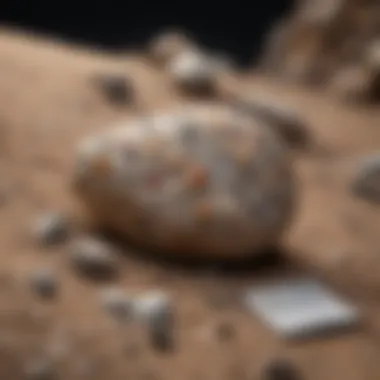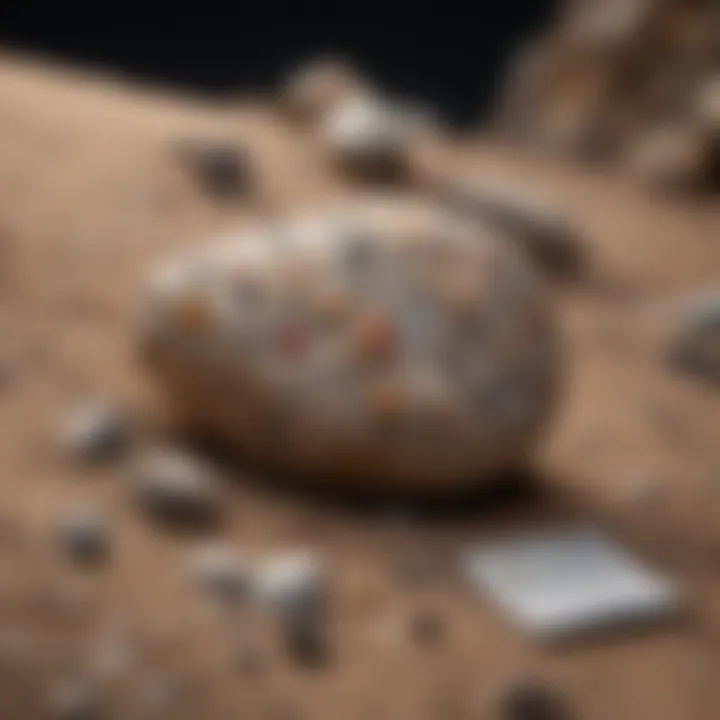Comprehensive Guide to Rock Identification Charts


Intro
Rock identification charts serve as a valuable resource for anyone curious about geology, be it enthusiasts, students, or professional geologists. These charts are designed to assist in the identification and classification of rocks and fossils, detailing distinctive characteristics that help in recognizing various forms. With a better understanding of rock types and their features, collectors can enhance their appreciation for the complexities of the natural world.
In this guide, we will delve into the history and origins of rock collecting, explore identification techniques, and discuss the significance of these charts. By the end, readers will have a comprehensive grasp of how to effectively utilize rock identification charts, enriching their geological knowledge and enhancing their collecting experience.
History and Origins
Overview of Collectibles, Rocks, and Fossils
The fascination with rocks and fossils dates back thousands of years. Ancient civilizations such as the Greeks and Romans documented their findings, often attributing mystical or symbolic meanings to specific stones. With the advancement of scientific inquiry, the systematic study of rocks emerged during the Renaissance, laying the groundwork for modern geology. Collecting rocks became a pursuit of both scholars and casual enthusiasts, as they sought to uncover the Earth's intricate story.
Historical Significance and Cultural Impact
Rocks and fossils have not only academic significance but also cultural relevance. They influence art, architecture, and even mythology. For instance, jade holds profound ceremonial importance in various cultures. Understanding this historical context enhances one’s connection to the natural world. Each collection item can represent a piece of human history, bridging the gap between our ancestors and modern collectors.
Identification and Classification
Guide to Identifying Rocks and Fossils
The process of rock identification can seem daunting at first. However, adopting a systematic approach makes it manageable. Here are some key aspects to consider when identifying rocks:
- Color: Observe the primary color and any secondary hues.
- Texture: Note the smoothness or roughness of the surface.
- Hardness: Use a scale to test the hardness of the rock.
- Grain Size: Determine if grains are coarse or fine.
- Composition: Analyze the minerals present, as this is crucial for classification.
Common Types and Variations
Various rock types characterize the planet's landscape. Here are some of the common variations:
- Igneous rocks: Formed from cooled lava or magma, these include granite and basalt.
- Sedimentary rocks: Composed of sediment, these types include limestone and sandstone.
- Metamorphic rocks: Created under heat and pressure, examples include schist and gneiss.
Understanding these categories allows collectors to better classify their finds and appreciate the geological processes that formed them.
"Rock identification is not just about classification, but also about connecting with the Earth's history."
Foreword to Rock Identification
Rock identification is not merely an intellectual exercise; it serves as a foundational skill for anyone engaged in geology, from hobbyists to professionals. The ability to accurately identify different rock types opens up a world of understanding regarding the earth's geological history and the processes that shape our planet. This guide delves into the intricacies of rock identification, providing a roadmap to recognizing various rock types and enhancing appreciation for their uniqueness.
Understanding and mastering rock identification can have several benefits. First, it develops observational skills. Being able to note differences in color, texture, and mineral composition enhances one’s ability to discern subtle yet crucial details in geological specimens. Such skills are essential for effective communication in academic and professional settings.
Second, rock identification plays a vital role in facilitating environmental understanding. Each rock type has a unique story, reflecting the conditions under which it formed. Recognizing these characteristics contributes to broader environmental awareness and helps foretell natural events like landslides or erosion based on rock types found in a specific location.
Finally, for collectors, knowing how to identify rocks can significantly elevate their collecting experience. It deepens the connection to the specimens and provides a greater sense of accomplishment and pride in building a rock collection that is not only visually appealing but also scientifically grounded.
Understanding the Importance of Rock Identification
Identification of rocks is essential for several reasons. To begin with, it allows individuals to classify and categorize their finds effectively. Different rocks, such as igneous, sedimentary, and metamorphic, each provide insights into different geological processes. Understanding these categories helps in predicting locations where certain minerals may be found, which is useful for both amateur and professional geologists.
Moreover, knowledge of rock types enhances one's ability to engage with the environment thoughtfully. For example, volcanic rocks can indicate past volcanic activity, while sedimentary rocks often reflect ancient water bodies. This information can inform not just academic research but also practical applications in construction, natural resource exploration, and environmental conservation.
Finally, rock identification fosters a sense of community among enthusiasts. By discussing finds and sharing insights, collectors and geologists can connect through mutual interests, contributing to the field's knowledge base while nurturing personal enjoyment.
Overview of Rock Identification Charts
Rock identification charts serve as invaluable tools for those interested in geology. These charts distill complex geological information into more manageable forms, allowing users to make swift identifications based on observable characteristics. They typically include diagrams, images, and descriptive texts that clarify the properties of various rock types.
Most identification charts categorize rocks based on essential traits like color, texture, mineral composition, and grain size. These aspects make it easier for individuals to make educated guesses about the rock’s identity without requiring extensive prior knowledge. The use of visual aids, such as photographs and charts, enhances understanding and retention, as humans tend to respond well to visual information.
Furthermore, modern rock identification charts have evolved to incorporate digital formats, providing interactive experiences for users. With the advent of mobile applications and online resources, collectors now have access to a vast array of information at their fingertips. This technological progression allows for a more dynamic and engaging approach to rock identification, encouraging exploration and learning.
"Knowledge of rock types empowers individuals to connect more meaningfully with their environment and enhances their ability to communicate geological concepts."


By emphasizing the systematic approach to rock identification, one can delve into the unique world of geological formations, enhancing their understanding of the earth's history and its ongoing narrative.
Types of Rocks in Identification Charts
Understanding the types of rocks is integral in the journey of rock identification. Different rock types exhibit distinct features that help in their classification. These rocks fall mainly into three categories: igneous, sedimentary, and metamorphic. Each type has unique formation processes and physical characteristics.
Knowing these types allows enthusiasts to identify rocks accurately, whether in the classroom or during fieldwork. The benefits of understanding these classifications include improved collection practices and the ability to appreciate Earth's geological history more deeply. Each rock type tells a story of its formation, providing clues about the environmental conditions that existed when it was created.
Igneous Rocks
Igneous rocks are formed from the cooling and solidification of molten material known as magma or lava. There are two main classifications within igneous rocks: intrusive and extrusive. Intrusive igneous rocks form below the Earth's surface when magma cools slowly, resulting in large, visible crystals. Granite is a prime example of this, showcasing a coarse texture and a mix of quartz, feldspar, and mica. Conversely, extrusive igneous rocks, such as basalt, form quickly at the surface, leading to smaller crystals or even a glassy texture.
When identifying igneous rocks, pay attention to texture and mineral composition. Color can also be a significant indicator, as different minerals contribute to the overall appearance. For instance, rocks rich in silica tend to be lighter in color, while those with higher iron and magnesium content are darker.
Sedimentary Rocks
Sedimentary rocks result from the accumulation of sediments, which can include minerals, organic material, and fragments of other rocks. They typically form in layers over time, often in bodies of water. Common examples include sandstone, limestone, and shale. These rocks are crucial for understanding Earth's history as they often contain fossils, providing insight into past life forms.
During identification, look for layering and grain size. Sedimentary rocks usually have a more uniform grain size, which can help differentiate them from igneous and metamorphic rocks. Fossils or other unique markings can also serve as valuable identification features.
Metamorphic Rocks
Metamorphic rocks are produced from the alteration of existing rocks, either igneous or sedimentary, due to high pressure, heat, or chemically active fluids. This transformation leads to changes in mineral composition and texture. Notable metamorphic rocks include schist, gneiss, and marble.
Identifying metamorphic rocks involves examining foliation or banding. Foliated rocks will appear layered or striped, while non-foliated rocks do not display this characteristic. An understanding of these traits is essential as it highlights the conditions under which the rock was formed.
In summary, recognizing the types of rocks in identification charts plays a vital role in rock study. Each category offers specific insights into the processes that shape our planet. By mastering these distinctions, rock collectors can enhance their appreciation for geological formations and phenomena.
Key Characteristics in Rock Identification
Identifying rocks effectively relies heavily on understanding several key characteristics. Each characteristic provides vital information that aids collectors and enthusiasts in differentiating between similar-looking specimens. Recognizing these traits can greatly enhance accuracy during identification and appreciation for the diverse forms of rocks. There are elements like color, texture, grain size, and mineral composition, which are crucial to draw correct conclusions about any given sample. Proper analysis of these features not only helps in practical identification but also deepens one’s understanding of geological history and processes.
Color and Texture Analysis
Color often acts as the first indicator in rock identification. The coloration can range from the deep blues of basalt to the soft creams of limestone. However, it’s important to remember that color can sometimes be misleading. Factors like weathering, impurities, and mineral content can affect a rock’s appearance. Thus, while noting color is significant, it should not be the sole criteria for identification.
Texture is equally crucial. It involves the feel and appearance of the rock surface, often categorized as fine, medium, or coarse. For example, granite has a coarse texture with visible crystals, while sandstone may show a more grainy surface. Observing how smooth or rough the surface is can yield additional insights.
Mineral Composition and Hardness
Another central aspect of rock identification involves examining the mineral composition. Different rocks are composed of different minerals, which dictate their characteristics. For instance, a rock made primarily of quartz will have different properties compared to one rich in feldspar.
One effective method for determining mineral composition is the use of the Mohs Hardness Scale. This scale ranges from 1 (talc) to 10 (diamond), allowing collectors to approximate a rock's durability and resistance to scratching. By performing simple scratch tests, one can gather important clues about the rock’s identity. Furthermore, knowing the hardness can help distinguish between rocks that may look similar but are composed of different minerals.
Grain Size and Arrangement
Grain size and arrangement provide additional layering of information for rock collectors. The grains in a rock can vary significantly in size, from microscopic to several centimeters. This is often indicative of the rock’s origin and formation process. For instance, igneous rocks may showcase larger grains if they cooled slowly beneath the Earth’s surface, resulting in a coarse texture.
Arrangement of the grains is equally valuable. Rocks with a random scattering of grains may indicate a volcanic origin, whereas those with a more structured alignment can suggest sedimentary processes. Graphical techniques, such as photomicrography, can be useful for examining finer details in grain arrangement. Collectively, examining grain size and arrangement aids enthusiasts in piecing together the history behind rock formation.
Understanding these key characteristics fosters not only the ability to identify rocks but also a greater appreciation for their complexity and beauty.
Practical Applications of Rock Identification Charts
Rock identification charts serve as a bridge between theory and practice in the field of geology. Their importance cannot be understated as they provide critical information that guides both amateurs and professionals. These charts enhance understanding and promote effective data collection strategies. Knowing how to use these tools can lead to advancements in various domains, from academic research to everyday hobbyist activities.
Fieldwork and Collecting
Fieldwork is at the heart of geology. It involves hands-on activities that allow individuals to gather rocks in their natural environment. Rock identification charts become invaluable during such excursions. They help collectors recognize and document specimens in real-time. By consulting these charts, hobbyists can avoid common pitfalls, such as misidentification.
In practice, using these charts can streamline the collection process. A collector might see a rock that looks like granite. Then, by referencing a chart, they confirm it has the correct texture and mineral composition. Additionally, carrying portable charts can facilitate note-taking, which can contribute valuable data for future study.


Some important tips for effective fieldwork include:
- Always carry a reliable identification chart.
- Note down specific location details of your finds.
- Be cautious of look-alike rock types.
Educational Use in Schools
Rock identification charts are also widely utilized in educational settings. They play a crucial role in geology curricula, helping students grasp concepts related to rock types and classifications. These tools encourage exploration and inquiry, promoting a hands-on learning experience.
Teachers can incorporate these charts into various activities. For instance, students can engage in practical workshops where they apply their knowledge to identify rocks. This active participation helps solidify their understanding of earth science concepts. Moreover, by using visual aids like charts, the retention of information is often enhanced.
Benefits of using rock identification charts in education include:
- Enhancing critical thinking skills through analysis.
- Fostering collaboration among students during group activities.
- Providing a clear visual reference that simplifies complex topics.
Professional Geological Surveys
In the realm of professional geology, identification charts serve a different, yet equally significant role. Geologists conducting environmental surveys use these tools to compile data about the geological features of an area. Accurate rock identification is essential for resource management, land-use planning, and environmental assessments.
Through systematic recording using identification charts, professionals can more clearly understand the geologic history of a region. This data is invaluable for making informed decisions that affect construction, conservation, and mining projects, among others.
Moreover, current trends show that professional miners and engineers increasingly rely on advanced technology. These technologies may include digital applications that incorporate traditional identification methods. However, the foundational skills provided by physical charts remain crucial even in a high-tech environment.
The Science Behind Rock Classification
Understanding the science behind rock classification is crucial for effective rock identification. It allows collectors, students, and professionals to grasp the underlying geological principles that influence the formation of various rock types. This section delves into essential elements, benefits, and considerations associated with rock classification.
Geological Principles in Rock Formation
Geological principles govern how rocks form, alter, and exist within the Earth's crust. Rocks are categorized into three primary types: igneous, sedimentary, and metamorphic. Each type has distinct processes for formation.
Igneous rocks originate from the solidification of molten rock material, known as magma, either beneath the Earth's surface or after erupting from a volcano. Their textures can indicate their formation environment—coarse-grained varieties like granite form deep underground, while fine-grained types such as basalt form rapidly at the surface.
Sedimentary rocks form from the accumulation and consolidation of mineral and organic particles over time. Layers of sediment compact to form rocks, often containing fossils and preserving important historical data about past environments. This makes them vital for understanding Earth’s history.
Metamorphic rocks arise from existing rocks subjected to intense pressure and temperature conditions, resulting in physical and chemical changes. This transformation process highlights the dynamic conditions within the Earth's crust, which are essential for accurate rock classification.
By grasping these principles, enthusiasts can more effectively analyze rock samples and categorize them in accordance with established geological frameworks.
Evolution of Rock Identification Techniques
Rock identification techniques have significantly evolved over time, influenced by advancements in technology and understanding of geological concepts. Historically, identification relied heavily on visual examination, tactile feedback, and basic tests for factors like hardness and streak. Geologists used simple hand lenses and hammers to assess rocks in field settings.
As the field of geology has progressed, a more systematic approach emerged. The development of rock identification charts and comprehensive guides allowed for standardized criteria, enabling easier comparisons between specimens.
Today, digital technologies have transformed how enthusiasts and professionals approach rock identification. Mobile applications now provide quick access to databases containing images and descriptions, making it simpler than ever to identify rocks in the field. Tools such as X-ray diffraction and scanning electron microscopy offer precise analysis of mineral compositions, blending traditional methods with cutting-edge science.
Common Errors in Rock Identification
Misidentifying rocks can lead to significant misunderstandings in geology. Rock identification relies on several criteria, including texture, mineral composition, and formation processes. For enthusiasts and professionals alike, recognizing potential pitfalls in this process is essential to enhance accuracy and deepen understanding.
Identifying rocks is not merely an exercise in observation. It demands a comprehensive approach that encompasses careful examination of characteristics and careful contextual awareness. Each error may invalidate conclusions or result in flawed assumptions regarding a rock's history and potential applications.
Misidentifying Similar-Looking Rocks
One of the most frequent issues in rock identification is the confusion between similar-looking rock types. For example, granite and rhyolite, both light-colored and coarse-grained, often present challenges as they can easily be mistaken for one another. This misidentification can occur due to superficial analysis that neglects key details, such as
- The mineral composition, where granite typically has larger crystals
- The formation process; granite is an igneous rock formed beneath the Earth’s surface, while rhyolite forms at the surface from lava flows.
To avoid this error, it is vital to observe rock characteristics more closely. Pay attention to the grain size and arrangement, perform scratch tests for hardness, and use identification charts as a reference for comparison. Employing tools, such as a hand lens, may also clarify differences that are not visible to the naked eye. Ultimately, becoming skilled at discerning subtle distinctions practices is a key asset for collectors or geologists.
Neglecting Contextual Information


Another prevalent error is ignoring the contextual information surrounding a rock’s occurrence. Understanding the geological setting where a rock is found can significantly assist in its identification. This context includes
- The surrounding rock formations
- The historical events leading to its formation and
- The presence of associated minerals and fossils.
For instance, finding a rock within a sedimentary basin usually indicates a different formation process and environment compared to one found in volcanic regions. When collectors overlook such information, they risk misidentifying rocks or neglecting to recognize their significance in geological research.
In sum, contextual awareness enhances the identification process. It informs collectors and geologists about environmental conditions that shaped the rock, allowing for a more educated interpretation of its characteristics. Fostering a practice that includes examination of context contributes to a richer understanding of the rock’s ecological and geological journey.
Evolution of Rock Identification Tools
Understanding the evolution of rock identification tools is crucial for both novice collectors and experienced geologists. The significance of this topic lies in the ongoing advancement of technologies and methodologies that enhance the accuracy and efficiency of rock classification. This evolution not only simplifies the identification process but also expands the knowledge base and appreciation of geology as a whole.
Historically, rock identification was primarily carried out using printed guides and physical samples. These resources provided a foundational understanding, yet they were limited in scope. The printed materials followed a fixed structure which could be inadequate for varying field conditions. As technology progressed, the transition to digital applications emerged, offering an array of benefits that improved the identification process.
"The shift from traditional methods to digital applications represents a transformative phase in geological study, bridging the gap between knowledge and accessibility."
From Printed Guides to Digital Applications
The shift from printed guides to digital applications marked a significant milestone in rock identification. Printed manuals had been the go-to tools for many years; these guides contained illustrations, descriptions of minerals, and notes on regional geology. While effective, they required a degree of prior knowledge and sometimes led to confusion due to the lack of interactivity.
Digital applications modernized the field. Mobile apps can offer interactive features such as augmented reality, allowing collectors to visualize rocks in 3D and compare them against a database of known specimens. The comprehensive databases found in many apps provide information on hardness, color, and common uses of different rock types. Additionally, cloud connectivity allows for real-time updates and community contributions, keeping the information current and expanding the user experience.
Innovative Technologies and Field Use
Innovative technologies play a pivotal role in transforming how rock identification is approached. Advanced tools such as portable X-ray fluorescence (XRF) analyzers enable geologists to determine the elemental composition of a rock sample on-site. This level of analysis was previously limited to laboratory environments. Moreover, these devices are becoming increasingly accessible to hobbyists and students, democratizing knowledge and encouraging widespread exploration.
Field sampling techniques have also evolved. Drones equipped with imaging technology can survey large geological areas quickly, identifying potential sites of interest. Data collected can then be analyzed using sophisticated software that applies machine learning algorithms to assist in classification based on visual patterns.
This blend of traditional methods and cutting-edge technologies represents a holistic approach to rock identification. The enhancement of tools fosters a richer understanding of geological processes and nurtures curiosity among rock enthusiasts.
Community and Resources for Rock Collectors
Rock collecting is an enriching hobby, but it can also be quite isolating for individuals. This is where the importance of community and resources comes into play. Joining forces with others who share a similar passion can significantly enhance both the learning curve and the enjoyment of the activity. Rock collectors benefit from shared experiences, tips, and knowledge when they engage with communities and access various resources.
A thriving community can provide answers to pressing questions, inspiration for new collecting techniques, and opportunities to exchange specimens. It also fosters networking and collaboration among individuals, which can lead to friendships and mentorships. Whether you are a novice gathering your first samples or an expert geologist, leveraging community resources can broaden your understanding of rocks and minerals.
Online Platforms and Forums
In the age of digital communication, online platforms and forums have revolutionized how rock collectors connect and share information. Websites like Reddit host dedicated subreddits that focus on rock collecting, discussions, and advice. For example, the subreddit r/mineral collecting serves as a knowledge hub where enthusiasts discuss their finds, share photographs, and exchange identification tips.
Websites like Facebook also host numerous groups dedicated to rock collecting. These groups allow users to share images, get feedback on specimens, or even participate in trading. The ability to connect with a global audience enriches your experience, providing perspectives and knowledge from a wide array of cultural backgrounds.
Consider engaging in these communities not just as a passive observer. Request feedback on your findings, share your own experiences, and participate in discussions. This active engagement can catalyze your growth as a collector.
Local Clubs and Societies
In addition to online interaction, local clubs and societies offer a more hands-on experience for rock enthusiasts. Clubs often host field trips, workshops, and lectures, providing rich opportunities for education and exploration. For instance, many mineralogical societies organize events such as rock swaps or public lectures, allowing members to gain new insights directly from experts in the field.
Connecting with local collectors can prove invaluable, especially for those starting out. Members are usually eager to share their knowledge on local geology, helping newcomers identify specimens found in their area. A more personal touch cultivates a sense of belonging and can lead to lifelong friendships among members who share the same passion.
In summary, engaging with both online platforms and local societies can significantly elevate your experience as a rock collector. These communities provide knowledge, resources, and camaraderie, essential elements for anyone serious about pursuing rock collecting. As you take steps to involve yourself in these groups, you will find that your appreciation and understanding of geology deepens.
The End: The Value of Rock Identification
Rock identification serves as a fundamental pillar for understanding our planet's geological history and transforming casual interest into significant knowledge. In this guide, we have elucidated the various dimensions of rock identification, from recognizing types of rocks to employing identification charts effectively. The value of rock identification lies not only in the pursuit of knowledge but also in gaining an appreciation for the intricate processes that govern our Earth's composition.
Through rock identification, enthusiasts can develop discernment in distinguishing between similar rock forms, recognize environmental factors influencing rock formation, and engage in meaningful discussions with fellow collectors and geologists. More than mere classification, understanding these natural elements fosters a greater sense of connection to our planet's past and present.
Enhancing Appreciation for Earth’s Natural History
Recognizing the different types of rocks unlocks the door to understanding Earth's historical narrative. Each rock type carries unique attributes that tell stories of ancient environments, volcanic activity, and sedimentary processes.
- Igneous Rocks: Each crystalline structure recounts the cooling and solidification processes of magma, offering insights into volcanic eruptions and tectonic movements.
- Sedimentary Rocks: Their layered formations and fossil contents reveal past life and climate conditions, providing evidence of Earth's evolving biosphere.
- Metamorphic Rocks: These showcase the impact of heat and pressure, exemplifying the dynamic nature of the Earth's crust over geological time.
"Understanding rock identification is key to unlocking our Earth's past, offering lessons in resilience and transformation."
The study of rocks does not merely serve a hobbyist's interest; it enriches one’s understanding of Earth's history. By engaging with this topic, rock collectors can delve deeper into our planet’s evolution, enriching their appreciation for nature’s artistry and its geological intricacies. This awareness can lead to informed discussions, where enthusiasts and professionals alike share insights and discoveries. Overall, the value of rock identification extends beyond classification; it is a pathway to a profound connection with our Earth's history.



